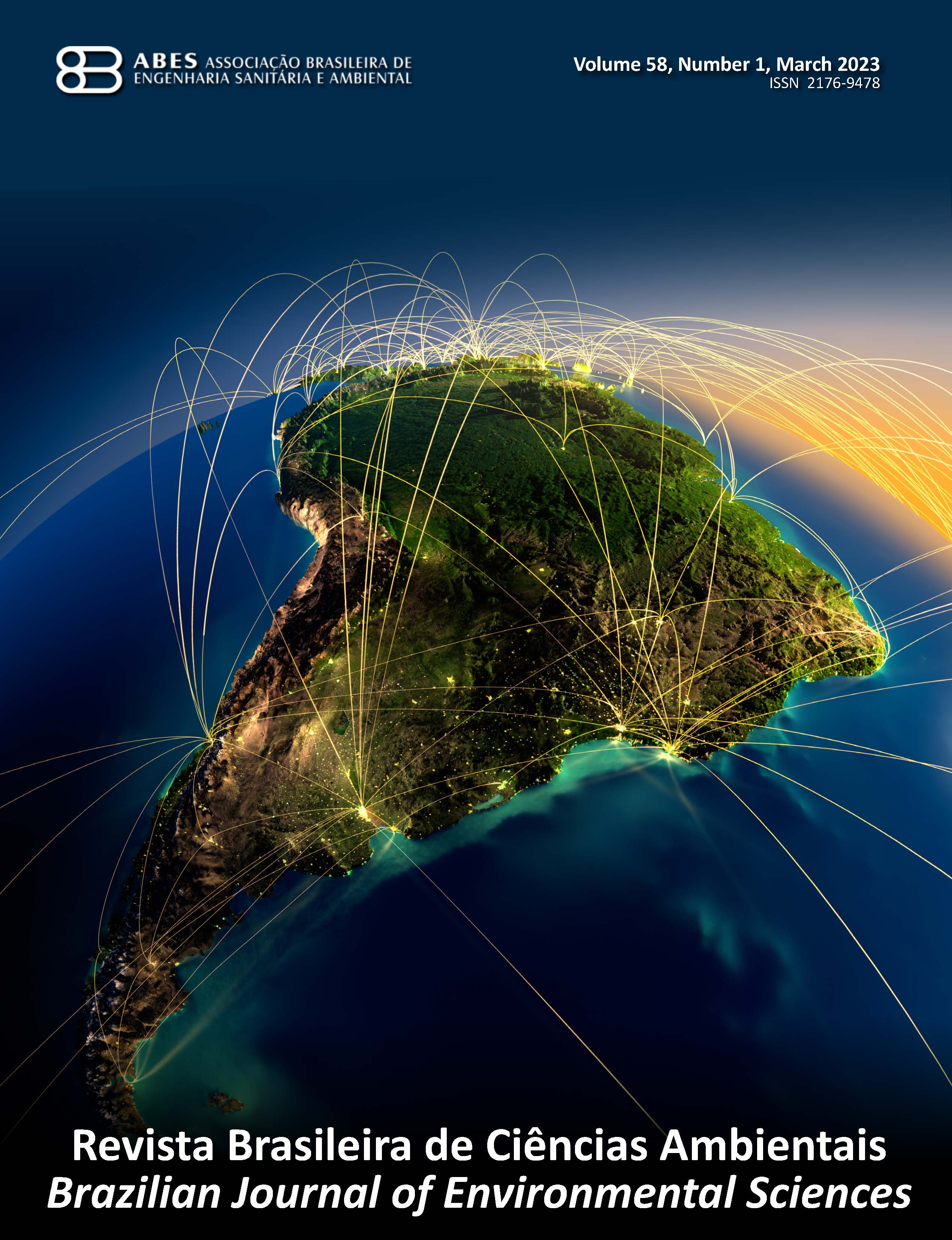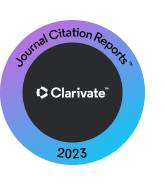Life cycle assessment of a vapor absorption refrigeration system applied to a university building in Northeast Brazil
DOI:
https://doi.org/10.5327/Z2176-94782277Palavras-chave:
gestão do ciclo de vida; análise de dominância; ReCiPe; openLCA; refrigeração por absorção; avaliação de impactos ambientaisResumo
Em consequência do aumento do aquecimento global e da crescente demanda por conforto térmico em regiões de clima tropical, os sistemas de refrigeração têm se tornado essenciais para assegurar condições adequadas em ambientes residenciais, comerciais e institucionais. Paralelamente, busca-se reduzir os impactos ambientais associados ao seu uso. Neste contexto, o presente estudo realiza uma avaliação do ciclo de vida (ACV) de um sistema de refrigeração por absorção de vapor de duplo efeito (SFAVDE) com capacidade de resfriamento de 352 kW, utilizando como fonte energética a queima direta de gás natural. Osprincipais objetivos deste trabalho são: i. fornecer uma avaliação do ciclo de vida para tecnologias SFAVDE utilizadas para suprir a demanda de resfriamento de um edifício universitário específico no Nordeste do Brasil e ii. realizar uma análise de dominância para identificar os principais responsáveis pelos impactos ambientais no SFAVDE. O estudo de ACV foi realizado utilizando o método ReCiPe endpoint (humanitário, ponderação média – H/A). As simulações foram realizadas por meio do software de código aberto openLCA versão 1.10.3, utilizando o banco de dados de inventário do ciclo de vida Ecoinvent 3.7.1. Os resultados das simulações mostraram que, nas classes ecossistema, saúde humana e recursos naturais, os maiores impactos ambientais foram causados por mudanças climáticas e ecossistemas (17,19%), mudanças climáticas e saúde humana (27,18%) e esgotamento fóssil e recursos naturais (43,70%). Emrelação ao estudo de dominância, os resultados indicaram que, para as etapas de transporte e operação, os principais impactos foram, respectivamente, o transporte aéreo (91.00%) e o uso de gás natural (97.00%). Na etapa de descarte do SFAVDE, o reaproveitamento do cobre resultou em uma redução de 34,61% no impacto ambiental em comparação com a destinação em aterro sanitário. Portanto, para mitigar os impactos ambientais do SFAVDE, recomenda-se avaliar alternativas de transporte, utilizar combustíveis renováveis na etapa de operação e priorizar o reúso do cobre durante as fases de fabricação e descarte.
Downloads
Referências
Associação Brasileira de Normas Técnicas (ABNT), 2006a. ABNT NBR ISO 14040 Second Edition Environmental Management - Life Cycle Assessment - Principles and Framework (Accessed April 11, 2024) at:. https://www.abntcatalogo.com.br/pnm.aspx?Q=dFBqV0RVdHpNVVBGeUdqb1lrUi85Y1d1NVl4bFhvUFRocVBDZFBGUjFTWT0=
Associação Brasileira de Normas Técnicas (ABNT), 2006b. ABNT NBR ISO 14044. Environmental Management - Life Cycle Assessment - Requirements and Guidance (Accessed April 29, 2024) at:. https://www.abntcatalogo.com.br/pnm.aspx?Q=QndvbDhMYldGMWdWR1lrY3g4K3ZqKzlHbncySVUrVGYydDZqTG1wVXh0UT0=
Abreu, R.P.; Correia, V.H.L.; Lourenço, A.B.; Marques, A.S.; Carvalho, M., 2022. Thermoeconomic and thermoenvironmental analysis of the chilled water system in a shopping mall. International Journal of Refrigeration, v. 134, 304-311. https://doi.org/10.1016/j.ijrefrig.2021.11.011.
Arshad, M.U.; Ghani, M.U.; Ullah, A.; Güngör, A.; Zaman, M., 2019. Thermodynamic analysis and optimization of double effect absorption refrigeration system using genetic algorithm. Energy Conversion and Management, v. 192, 292-307. https://doi.org/10.1016/j.enconman.2019.03.083.
Associação Brasileira de Normas Técnicas (ABNT). ABNT NBR 10004: solid waste classification. Rio de Janeiro: ABNT, 2004.
Ayer, N.W.; Dias, G., 2018. Supplying renewable energy for Canadian cement production: Life cycle assessment of bioenergy from forest harvest residues using mobile fast pyrolysis units. Journal of Cleaner Production, v. 175, 237-250. https://doi.org/10.1016/j.jclepro.2017.12.040.
Baumann, H.; Berlin, J.; Brunklaus, B.; Lindkvist, M.; Löfgren, B.; Tillman, A.-M., 2011. The usefulness of an actor’s perspective in LCA. In: Finkbeiner, M. (Eds.), Towards Life Cycle Sustainability Managemen. Springer, Dordrecht, pp. 73-83. https://doi.org/10.1007/978-94-007-1899-9_8.
Bellos, E.; Chatzovoulos, I.; Tzivanidis, C., 2021. Yearly investigation of a solar-driven absorption refrigeration system with ammonia-water absorption pair. Thermal Science and Engineering Progress, v. 23, 100885. https://doi.org/10.1016/j.tsep.2021.100885.
Castaño-Rosa, R.; Barrella, R.; Sánchez-Guevara, C.; Barbosa, R.; Kyprianou, I.; Paschalidou, E.; Thomaidis, N.S.; Dokupilova, D.; Gouveia, J.P.; Kádár, J.; Hamed, T.A.; Palma, P., 2021. Cooling degree models and future energy demand in the residential sector. A seven-country case study. Sustainability (Switzerland), v. 13 (5), 2987. https://doi.org/10.3390/su13052987.
Cavalcanti, E.J.C.; Carvalho, M.; Ochoa, A.A.V., 2019. Exergoeconomic and exergoenvironmental comparison of diesel-biodiesel blends in a direct injection engine at variable loads. Energy Conversion and Management, v. 183, 450-461. https://doi.org/10.1016/j.enconman.2018.12.113.
César, J.C.; Ortiz, J.C.; Ochoa, G.V.; Restrepo, R.R.; Nuñez Alvarez, J.R., 2021. A new computational tool for the development of advanced exergy analysis and lca on single effect libr-h2o solar absorption refrigeration system. Lubricants, v. 9 (8), 76. https://doi.org/10.3390/lubricants9080076.
Dastjerdi, B.; Strezov, V.; Kumar, R.; He, J.; Behnia, M., 2021. Comparative life cycle assessment of system solution scenarios for residual municipal solid waste management in NSW, Australia. Science of the Total Environment, v. 767, 144355. https://doi.org/10.1016/j.scitotenv.2020.144355.
Dong, D.; van Oers, L.; Tukker, A.; van der Voet, E., 2020. Assessing the future environmental impacts of copper production in China: Implications of the energy transition. Journal of Cleaner Production, v. 274, 122825. https://doi.org/10.1016/j.jclepro.2020.122825.
Google. Google Maps (Accessed November 28, 2024) at: https://www.google.com/maps.
Guillén-Lambea, S.; Carvalho, M.; Delgado, M.; Lazaro, A., 2021. Sustainable enhancement of district heating and cooling configurations by combining thermal energy storage and life cycle assessment. Clean Technologies and Environmental Policy, v. 23 (3), 857-867. https://doi.org/10.1007/s10098-020-01941-9.
Hara Chakravarty, K.; Sadi, M.; Chakravarty, H.; Sulaiman Alsagri, A.; James Howard, T.; Arabkoohsar, A., 2022. A review on integration of renewable energy processes in vapor absorption chiller for sustainable cooling. Sustainable Energy Technologies and Assessments, v. 50, 101822. https://doi.org/10.1016/j.seta.2021.101822.
International Energy Agency (IEA), 2021. The Role of Critical Minerals in Clean Energy Transitions. Paris: IEA (Accessed March 10, 2022) at:. https://www.iea.org/reports/the-role-of-critical-minerals-in-clean-energy-transitions.
Kanchiralla, F.M.; Brynolf, S.; Olsson, T.; Ellis, J.; Hansson, J.; Grahn, M., 2023. How do variations in ship operation impact the techno-economic feasibility and environmental performance of fossil-free fuels? A life cycle study. Applied Energy, v. 350, 121773. https://doi.org/10.1016/j.apenergy.2023.121773.
Leite, C.A.A.F.; Alcântara, S.C.S.; Ochoa, A.A.V.; dos Santos, C.A.C.; Dutra, J.C.C.; Costa, J.A.P.; Michima, P.S.A.; Silva, H.C.N., 2021. Natural gas based cogeneration system proposal to a textile industry: a financial assessment. Energy Efficiency, v. 14 (2), 20. https://doi.org/10.1007/s12053-021-09927-2.
LG, 2020. Absorption Chiller Catalog (Accesed May 21, 2022) at:. https://www.lg.com/br/business/download/airsolution/202004_Catalogo_ChillerAbsorcao[20210429_024814580].pdf?srsltid=AfmBOoqDUAiAblZRDMTUuN7pqg3hpvi_OnNZkOfG2d7h23ugfTZl5DS6.
Li, Q.; Zhao, S.; Wang, D.; Song, Q.; Zhou, S.; Wang, X.; Li, Y., 202). Simulation Study on Solar Single/Double-Effect Switching LiBr-H2O Absorption Refrigeration System. Energies, v. 16 (7), 3220. https://doi.org/10.3390/en16073220.
Lin, H.; Clavreul, J.; Jeandaux, C.; Crawley, J.; Butnar, I., 2021. Environmental life cycle assessment of heating systems in the UK: Comparative assessment of hybrid heat pumps vs. condensing gas boilers. Energy and Buildings, v. 240, 110865. https://doi.org/10.1016/j.enbuild.2021.110865.
Longo, S.; Cellura, M.; Girardi, P., 2020. Life Cycle Assessment of electricity production from refuse derived fuel: A case study in Italy. Science of the Total Environment, v. 738, 139719. https://doi.org/10.1016/j.scitotenv.2020.139719.
Marques, A.C., 2018. Exergoeconomic and environmental evaluation of a micro-cogeneration unit. Doctoral Thesis, technology center, Universidade Federal da Paraíba, Paraíba. Retrieved 2023-09-05, from https://repositorio.ufpb.br/
Marques, A.S.; Carvalho, M.; Ochoa, A.A.V.; Abrahão, R.; Santos, C.A.C., 2021. Life cycle assessment and comparative exergoenvironmental evaluation of a micro-trigeneration system. Energy, v. 216, 119310. https://doi.org/10.1016/j.energy.2020.119310.
Micheli, M.; Moore, D.; Bach, V.; Finkbeiner, M., 2022. Life-cycle assessment of power-to-liquid kerosene produced from renewable electricity and CO2 from direct air capture in Germany. Sustainability (Switzerland), v. 14 (17), 10658. https://doi.org/10.3390/su141710658.
Nwodo, M.N.; Anumba, C.J., 2019. A review of life cycle assessment of buildings using a systematic approach. Building and Environment, v. 162, 106290. https://doi.org/10.1016/j.buildenv.2019.106290.
Osman, A.I.; Mehta, N.; Elgarahy, A.M.; Al-Hinai, A.; Al-Muhtaseb, A.H.; Rooney, D.W., 2021. Conversion of biomass to biofuels and life cycle assessment: a review. In Environmental Chemistry Letters, v. 19 (6), 4075-4118. https://doi.org/10.1007/s10311-021-01273-0.
Panahizadeh, F.; Hamzehei, M.; Farzaneh-Gord, M.; Villa, A., 2022. Thermo-economic analysis and optimization of the steam absorption chiller network plant. Thermal Science, v. 26 (1 Part A), 95-106. https://doi.org/10.2298/TSCI200619058P.
Panahizadeh, F.; Hamzehei, M.; Farzaneh-Gord, M.; Villa, A.A.O., 2021. Evaluation of machine learning-based applications in forecasting the performance of single effect absorption chiller network. Thermal Science and Engineering Progress, v. 26, 101087. https://doi.org/10.1016/j.tsep.2021.101087.
Rajput, P.; Malvoni, M.; Kumar, N.M.; Sastry, O.S.; Jayakumar, A., 2020. Operational performance and degradation influenced life cycle environmental-economic metrics of mc-si, a-si and hit photovoltaic arrays in hot semi-arid climates. Sustainability (Switzerland), v. 12 (3), 1075. https://doi.org/10.3390/su12031075.
Xu, S.; Wang, J.; Sun, H.; Huang, L.; Xu, N.; Liang, Y., 2022. Life cycle assessment of carbon emission from natural gas pipelines. Chemical Engineering Research and Design, v. 185, 267-280. https://doi.org/10.1016/j.cherd.2022.07.018.
Yu, M.; Liu, X.; Chen, Y.; Zhang, Z.; Wang, Y.; Zhang, J.; Han, Y., 2022. A 4E analysis of a novel coupling process of syngas purification and CO2 capture, transcritical CO2 power and absorption refrigeration. Chemical Engineering Journal, v. 445, 136757. https://doi.org/10.1016/j.cej.2022.136757.
Zhang, F.; Yan, Y.; Liao, G.; E.J., 2022. Energy, exergy, exergoeconomic and exergoenvironmental analysis on a novel parallel double-effect absorption power cycle driven by the geothermal resource. Energy Conversion and Management, v. 258, 115473. https://doi.org/10.1016/j.enconman.2022.115473.
Zhou, Y.; Xu, G.; Li, H.; Chen, Y.; Xu, X.; Li, M., 2023. Effect of greenhouse gas emissions on the life cycle of biomass energy production and conversion under different straw recycling modes. Environmental Research, v. 238 (Part 2), 117184. https://doi.org/10.1016/j.envres.2023.117184.
Zhu, H.; Guo, B.; Geng, W.; Chi, J.; Guo, S., 2022. Simulation of an improved solar absorption refrigeration system with phase change materials. Energy Reports, V. 8, 3671-3679. https://doi.org/10.1016/j.egyr.2022.02.306.
Downloads
Publicado
Como Citar
Edição
Seção
Licença
Copyright (c) 2025 Revista Brasileira de Ciências Ambientais

Este trabalho está licenciado sob uma licença Creative Commons Attribution 4.0 International License.

























